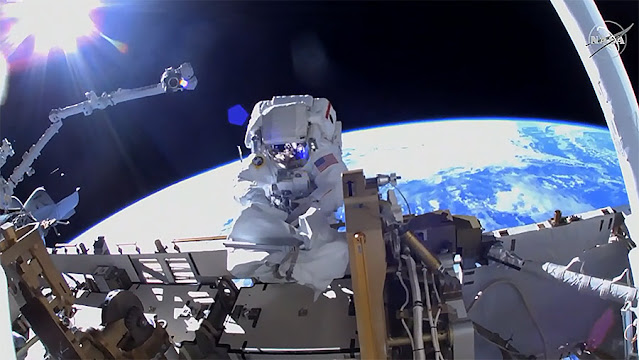EVA - Extra Vehicular Activities patch.
March 15, 2022
NASA astronauts Kayla Barron and Raja Chari concluded their spacewalk at 3:06 p.m. EDT after 6 hours and 54 minutes in preparation for upcoming solar array installation.
Image above: NASA astronauts Kayla Barron and Raja Chari will work outside the space station to prepare it for the next roll-out solar array due to be delivered soon. Image Credit: NASA.
Barron and Chari completed their major objectives for today to prepare the space station for upcoming solar array upgrades by assembling and installing modification kits. The duo built a support bracket onto which a future ISS roll out solar array (iROSA) will be mounted. So far, two of six iROSAs have been deployed on station with four additional arrays to be delivered. The arrays will ultimately augment six of the station’s eight power channels, increasing the station’s total available power from 160 kilowatts to up to 215 kilowatts.
Image above: Six iROSA solar arrays in the planned configuration will augment the power drawn from the existing arrays on the International Space Station. Image Credit: Boeing.
It was the 247th spacewalk in support of space station assembly, upgrades and maintenance, and was the first in Chari’s career and the second for Barron. Chari and Barron are in the midst of a planned six-month science mission living and working aboard the microgravity laboratory to advance scientific knowledge and demonstrate new technologies for future human and robotic exploration missions as part of NASA’s Moon and Mars exploration approach, including lunar missions through NASA’s Artemis program.
Image above: NASA astronaut Kayla Barron works to ready the space station for a third set of roll-out solar arrays about 260 miles above the Earth. Image Credit: NASA TV.
Astronaut roles for the next spacewalk on March 23 will be confirmed soon. NASA TV coverage for the March 23 spacewalk will begin at 7:30 a.m. for a spacewalk expected to begin around 8:50am.
For the Wednesday, March 23, spacewalk, designated U.S. EVA 80, two astronauts will install hoses on a Radiator Beam Valve Module that routes ammonia through the station’s heat-rejecting radiators to keep systems at the proper temperature. The crew members also will install a power and data cable on the Columbus module’s Bartolomeo science platform, replace an external camera on the station’s truss, and conduct other upgrades to station hardware.
NASA Astronaut Breaks American Space Record
Vande Hei made it into record books on Tuesday, March 15, 2022: He broke the record for the most consecutive days in space by an American explorer.
Vande Hei arrived at the space station on April 9, 2021, and is expected to return home March 30, 2022, after spending 355 days in low-Earth orbit. This duration breaks the previous record, held by NASA astronaut Scott Kelly, by 15 days.
In this image from August 2021, NASA astronaut Mark Vande Hei sits and reads while aboard the International Space Station. Image Credit: NASA.
His then-crewmate Thomas Pesquet, who snapped the picture, said: "If you are reading this sitting down, maybe on a sofa or couch, consider that we will not sit down... until we are back on Earth! Of course we don't need to sit down up here, and I am not complaining at all, but sometimes that wonderful feeling of relaxation – that moment when you change from running around to letting yourself drop into a chair – that moment can be wonderful I am sure you all agree, and we do miss it sometimes! I think Mark did here too and made a makeshift reading table to enjoy a book – absolutely unnecessary in weightlessness but so nice to construct some semblances of normal life every now and again!"
Related links:
Expedition 66: https://www.nasa.gov/mission_pages/station/expeditions/expedition66/index.html
U.S. Quest airlock: https://www.nasa.gov/mission_pages/station/structure/elements/joint-quest-airlock
Starboard-4 truss structure: https://www.nasa.gov/mission_pages/stat.ion/structure/elements/truss-structure
Space Station Research and Technology: https://www.nasa.gov/mission_pages/station/research/overview.html
International Space Station (ISS): https://www.nasa.gov/mission_pages/station/main/index.html
Images (mentioned), Text, Credits: NASA/Mark Garcia.
Greetings, Orbiter.ch





